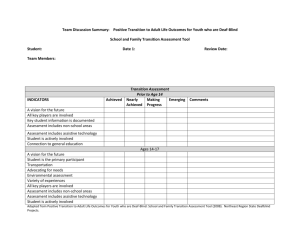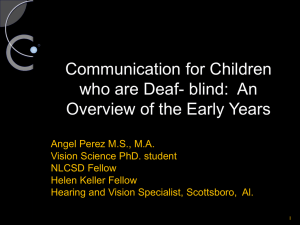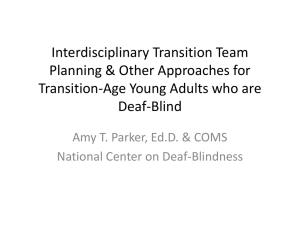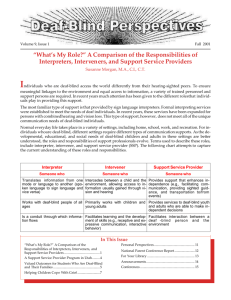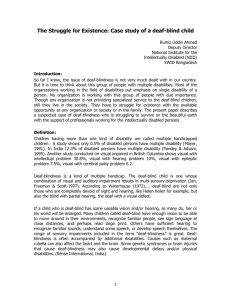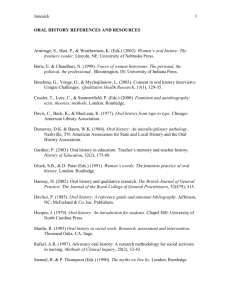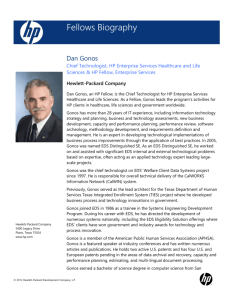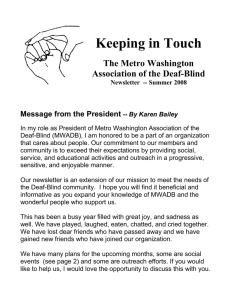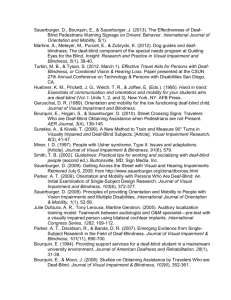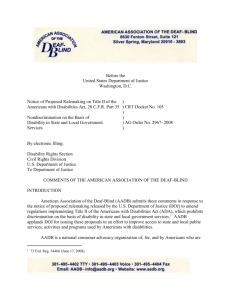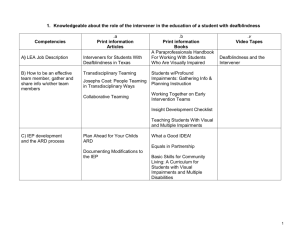Harmonious Interactions: Resource Information
advertisement
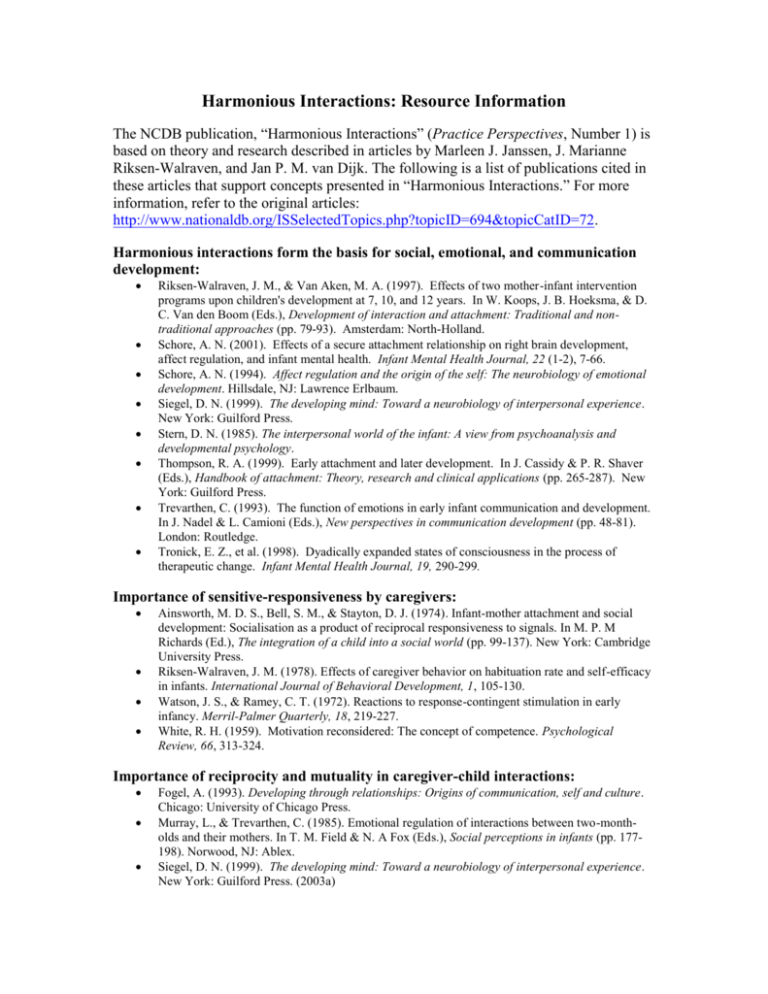
Harmonious Interactions: Resource Information The NCDB publication, “Harmonious Interactions” (Practice Perspectives, Number 1) is based on theory and research described in articles by Marleen J. Janssen, J. Marianne Riksen-Walraven, and Jan P. M. van Dijk. The following is a list of publications cited in these articles that support concepts presented in “Harmonious Interactions.” For more information, refer to the original articles: http://www.nationaldb.org/ISSelectedTopics.php?topicID=694&topicCatID=72. Harmonious interactions form the basis for social, emotional, and communication development: Riksen-Walraven, J. M., & Van Aken, M. A. (1997). Effects of two mother-infant intervention programs upon children's development at 7, 10, and 12 years. In W. Koops, J. B. Hoeksma, & D. C. Van den Boom (Eds.), Development of interaction and attachment: Traditional and nontraditional approaches (pp. 79-93). Amsterdam: North-Holland. Schore, A. N. (2001). Effects of a secure attachment relationship on right brain development, affect regulation, and infant mental health. Infant Mental Health Journal, 22 (1-2), 7-66. Schore, A. N. (1994). Affect regulation and the origin of the self: The neurobiology of emotional development. Hillsdale, NJ: Lawrence Erlbaum. Siegel, D. N. (1999). The developing mind: Toward a neurobiology of interpersonal experience. New York: Guilford Press. Stern, D. N. (1985). The interpersonal world of the infant: A view from psychoanalysis and developmental psychology. Thompson, R. A. (1999). Early attachment and later development. In J. Cassidy & P. R. Shaver (Eds.), Handbook of attachment: Theory, research and clinical applications (pp. 265-287). New York: Guilford Press. Trevarthen, C. (1993). The function of emotions in early infant communication and development. In J. Nadel & L. Camioni (Eds.), New perspectives in communication development (pp. 48-81). London: Routledge. Tronick, E. Z., et al. (1998). Dyadically expanded states of consciousness in the process of therapeutic change. Infant Mental Health Journal, 19, 290-299. Importance of sensitive-responsiveness by caregivers: Ainsworth, M. D. S., Bell, S. M., & Stayton, D. J. (1974). Infant-mother attachment and social development: Socialisation as a product of reciprocal responsiveness to signals. In M. P. M Richards (Ed.), The integration of a child into a social world (pp. 99-137). New York: Cambridge University Press. Riksen-Walraven, J. M. (1978). Effects of caregiver behavior on habituation rate and self-efficacy in infants. International Journal of Behavioral Development, 1, 105-130. Watson, J. S., & Ramey, C. T. (1972). Reactions to response-contingent stimulation in early infancy. Merril-Palmer Quarterly, 18, 219-227. White, R. H. (1959). Motivation reconsidered: The concept of competence. Psychological Review, 66, 313-324. Importance of reciprocity and mutuality in caregiver-child interactions: Fogel, A. (1993). Developing through relationships: Origins of communication, self and culture. Chicago: University of Chicago Press. Murray, L., & Trevarthen, C. (1985). Emotional regulation of interactions between two-montholds and their mothers. In T. M. Field & N. A Fox (Eds.), Social perceptions in infants (pp. 177198). Norwood, NJ: Ablex. Siegel, D. N. (1999). The developing mind: Toward a neurobiology of interpersonal experience. New York: Guilford Press. (2003a) Stern, D. N. (1985). The interpersonal world of the infant: A view from psychoanalysis and developmental psychology. Trevarthen, C. (1993). The function of emotions in early infant communication and development. In J. Nadel & L. Camioni (Eds.), New perspectives in communication development (pp. 48-81). London: Routledge. Difficulties with interactions: Amaral, I. (2002). Communicative interactions between children with multiple disabilities and their teachers: Effects of an intervention process. Doctoral dissertation, University of Porto, Portugal, May 29, 2002. Bjerkan, B. (1996). When do congenital deaf-blinds communicate? On the distinction between communication and other types of social contact. In M. Laurent (Ed.), Communication and congenital deafblindness: The development of communication. What is new? (p. 179-195. Paris: Centre National de Suresnes. Downing, J. (1993). Communication intervention for individuals with dual sensory impairments. In L. Kupper (Ed.), The national symposium on effective communication for children and youth with severe disabilities (pp. 109-134). (ERIC Document Reproduction Service No. ED 359 698). Difficulties with interaction can cause emotional and behavioral problems: Learned helplessness Marks, S. B. (1998). Understanding and preventing learned helplessness in children who are congenitally deaf-blind. Journal of Visual Impairment and Blindness, 93, 200-212. Meyers, S. O. (1981). A general overview of disabilities and handicaps. In S. Walsh & Holzberg, R. (Eds.), Understanding and educating the deaf-blind /severely and profoundly handicapped (pp. 43-50). An International Perspective. Spring filed, IL: Charles C. Thomas. Rowland, C. & Schweigert, P. (1997). Overcoming helplessness: Hands-on problem solving skills for children with deaf-blindness, final report. Vancouver: Washington State University. Emotional and behavioral problems Durand, V. M. & & Berotti, D. (1991, November). Treating behavior problems with communication. Journal of the American Speech Language Association, 37-39. Luiselli, J. K. (1992). Assessment and treatment of self-injury in a deaf-blind child. Journal of Developmental and Physical Disabilities, 4, 219-226. Seligson, J. L. (1983). Problems of psychiatric care of a deaf-blind population. International Journal of Psychiatry Medicine, 13, 85-92. Sisson L. A., Hersen, M., & Van Hasselt, V. B. (1993). Improving the performance of youth with dual sensory impairment: Analyses and social validation of procedures to reduce maladaptive responding in vocational and leisure settings. Behavior Therapy, 24, 553-571. Sisson L. A., Van Hasselt, V. B., Hersen, M., & Aurand, J. C. (1988). Tripartite behavioral intervention to reduce stereotypic and disruptive behaviors in young multihandicapped children. Behavior Therapy, 19, 503-526. Van Dijk, J., Carlin, R., Hewitt, H. (1991). Persons handicapped by rubella: Victors and victims, a follow-up study. Lisse, the Netherlands: Swets & Zeitlinger. When vision and hearing are decreased or absent, the use of other senses is necessary to obtain and process information: McInnes, J. M., & Treffey, J. (1982). Deaf-blind infants and children: A developmental guide. Toronto: University of Toronto Press. Murdoch, H. (1994). The development of infants who are deaf-blind: A case study. Journal of Visual Impairments and Blindness, 88, 357-367. Preisler, G. (1996). The consequences of sensory and multiple impairments on early communicative development between mother and child. In M. Laurent (Ed.), Communication and congenital deafblindness: The development of communication. What is new? (pp. 179195). Paris: Centre National de Surenes. 2 Children who are deaf-blind often use their own unique communication signals: Bjerkan, B. (1996). When do congenital deaf-blinds communicate? On the distinction between communication and other types of social contact. In M. Laurent (Ed.), Communication and congenital deafblindness: The development of communication. What is new? (p. 179-195. Paris: Centre National de Suresnes. (2003a) Eibl-Eibesfeldt, I. (1973). The expressive behaviour of the deaf-and-blind-born. In M. von Cranach and I. Vine (Eds.), Social communication and movement: European Monographs in Social Psychology, 4 (pages 163-194). New York: Academic Press. (2003a) Goode, D. (1994). A world without words: The social construction of children born deaf and blind. Philadelphia: Temple University Press. (2003a) Preisler, G. (1996). The consequences of sensory and multiple impairments on early communicative development between mother and child. In M. Laurent (Ed.), Communication and congenital deafblindness: The development of communication. What is new? (pp. 179195). Paris: Centre National de Surenes. (2002) Harmonious interactions research builds upon previous work by experts in the field of deaf-blindness related to communication: Downing, J. (2002). Including students with severe and multiple disabilities in typical classrooms: Practical strategies for teachers (2nd ed.). Baltimore, MD: Paul H. Brookes. Enerstvedt, R. T. (1996). Legacy of the past: Those who are gone but have not left. Dronninglund, Denmark: Basis-Tryk. Hagood, L. (1997). Communication: A guide for teaching students with visual and multiple impairments. Austin: Texas School for the Blind and Visually Impaired. Jurgens, M. R. (1977). Confrontation between the young deaf-blind child and the outer world: How to make the world surveyable by organized structure. Lisse, the Netherlands: Swets & Zeitlinger. MacFarland, S. Z. C. (1993). Teacher’s understanding and implementation of Van Dijk’s learning theory for students who are deaf-blind. Unpublished doctoral dissertation, University of Arizona. McInnes, J. M. (1999). A guide to planning and support for individuals who are deafblind. Toronto: University of Toronto Press. McInnes, J. M., & Treffey, UJ. (1982). Deaf-blind infants and children: A developmental guide. Toronto: University of Toronto Press. Miles, B., & Riggio, M. (1999). Remarkable conversations: A guide to developing meaningful communication with children and young adults who are deafblind. Watertown, MA: Perkins School for the Blind. Siegel-Causey, E., & Downing, J. (1987). Nonsymbolic communication development. In L. Goetz, D. Guess, & K. Stremel-Campbell (Eds.), Innovative program design for individuals with dual sensory impairments (pp. 15-48). Baltimore, MD: Paul H. Brookes. Stillman, R. (1992). Communication: Presentation. In J. W. Reiman & P. A. Johnson (Eds.), Proceedings of the national symposium on children and youth who are deaf-blind (pp. 129-139). Monmouth, OR: Teaching Research. Stillman, R. (1984). Developing prelanguage communication in the severely handicapped: An interpretation of the Van Dijk method. Seminars in Speech and Language, 5, 159-170. Stillman, R., & Siegel-Causey, E. (1989). Introduction to nonsymbolic communication. In E. Siegel-Causey & D. Guess (Eds.), Enhancing nonsymbolic communication interactions among learners with severe disabilities (pp. 1-13). Baltimore, MD: Paul H. Brookes. Stremel-Campbell, K., & Wilson, R. (1984). Providing services for learners with severe handicaps: A series of in-service training modules for developing communication, systematic instruction, data-based decision making, functional curricular content, and social integration. Hattiesburg: University of Southern Mississippi. Van Dijk, J. (1967). The non-verbal deaf-blind child and his world. His outgrowth towards the world of symbols. In Verzamelde Studies I (pp. 73-110). Sint-Michielsgestel, the Netherlands: Instituut voor Doven. 3 Van Dijk, J., & Nelson, C. (1998). History and change in the education of children who are deafblind since the rubella epidemic of the 1960s: Influence of methods developed in the Netherlands. Deaf-Blind Perspectives, 5, 1-5. Writer, J. (1987). A movement-based approach to the education of students who are sensory impaired/multihandicapped. In L. Goetz, D. Guess, & K. Stremel-Campbell (Eds.), Innovative program design for individuals with dual sensory impairments (pp. 15-48). Baltimore, MD: Paul H. Brookes. 4

